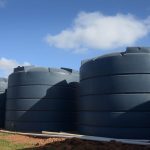Rotational Moulding Colouring P.3
The benefits and risks of pigments in rotational moulding have already been assessed in previous blog posts; Colouring P1 and Colouring P2, and this blog post will look at how to incorporate it into PE for optimal results.
Pigments can be incorporated into polyethylene in a number of ways. Dry blending of powder with pigments can give good results, however, this practice is not recommended as the pigment may not be properly dispersed and this will reduce the impact resistance and tensile strength of the moulding. High-speed blending in, for example, a Henschel-type mixer, will give better results than simple tumble blending of the powder components.
Coloured powders obtained by grinding compounds into which the pigment has been incorporated will lead to mouldings with the best balance of physical properties. This is particularly so for mouldings which will be subject to stress during their use. In the melt compounding process, the pigment is premixed in a masterbatch form, which is then mixed with the polymer granules as it passes through an extruder which melts and mixes the two materials together to form a uniform coloured melt.



